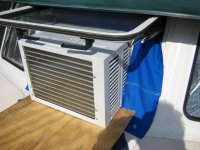The smallest honda generator made was about 350 watts--but that was years ago. The current smallest of the inverter/Alternator series: EU1000i, is 1000 watts max. Ratted running load is 900 watts or 7.5 amps 120 volts AC.
The engine in this unit is rated at 1.8 hp.
The 12 volt output of this unit is 8.3 amps for battery charging.
I doubt that you will find any roof top air units which will start on 8.3 amps (120 volts AC--and max starting load). You can find some which will run on the EU2000i.
Another option, is to go with an inverter of 2500 watts to 3000 watts, and a large bank of golf cart batteries.--then you could run a Coleman Polar Cub which will be 8300 to 9200 BTU and adequate to cool the boat. However, I do not see this as practical, since the batteries will be very heavy, and will only run a relitatively short time before needing re-charging. Recharging can be a difficult proposition. I suspose that you could use 4 Golf Cart batteries with an inverter, plus run the generator, with the largest battery charger which it would handle, to keep up with most of the running load. This will not be cheap, nor practical, because of the weight and space used by the batteries. Sportsmobile camper van conversions use a variation of this, using the engine alternator to keep up the batteries (a bit smaller battery bank)--but the automotive alternator will put out much more than the battery charger.
An option, which we often use, is a "Endless breeze" or Walmart O2 fan--which runs on 12 volts, has a good air flow, and can be fixed either in the foreard opening window or in the foredeck hatch. We sailed for many years in the tropics without an air conditioning--as long as there was a breeze it is fine.
Good luck--you have some home work to do.

